Mathematical Handbook for Scientists and Engineers: Definitions, Theorems, and Formulas for Referenc
Original price was: ₹3,553.02.₹2,842.42Current price is: ₹2,842.42.
ISBN: 9780486411477
Author/Editor: Granino
Publisher: DOVER
Year: 2000
2 in stock (can be backordered)
Description
Anyone whose work involves mathematics and its methodology — especially engineers and scientists — will appreciate this authoritative handbook, which provides convenient access to information from every area of mathematics. A reliable source of helpful definitions, theorems, and formulas, it features an easy-to-follow format outlining mathematical methods for speedy, accurate solutions to the most demanding problems.
Among the topics covered are Fourier transforms, z transforms, linear and nonlinear programming, calculus of variations, random-process theory, special functions, combinatorial analysis, numerical methods, game theory, and much more. By concisely tabulating related formulas and omitting proofs, the authors have packed a remarkably large amount of material into a single, handy volume. Appropriate introductions, notes, and cross-references appear throughout the text, showing the interrelations of various topics and their significance to science and engineering.
Illustrated throughout with numerous figures and tables, this volume represents a valuable resource for both students and professionals.
Additional information
| Weight | 0.69 kg |
|---|
Product Properties
| Year of Publication | 2000 |
|---|---|
| Table of Contents | Preface Chapter 1. Real and Complex Numbers. Elementary Algebra. 1.1. Introduction. The Real-number System 1.2. "Powers, Roots, Logarithms, and Factorials. Sum and Product Notation" 1.3. Complex Numbers 1.4. Miscellaneous Formulas 1.5. Determinants 1.6. Algebraic Equations: General Theorems 1.7. Factoring of Polynomials and Quotients of Polynomials. Partial Fractions 1.8. "Linear, Quadratic, Cubic, and Quartic Equations" 1.9. Systems of Simultaneous Equations 1.10. "Related Topics, References, and Bibliography" Chapter 2. Plane Analytic Geometry 2.1. Introduction and Basic Concepts 2.2. The Straight Line 2.3. Relations Involving Points and Straight Lines 2.4. Second-order Curves (Conic Sections) 2.5. "Properties of Circles, Ellipses, Hyperbolas, and Parabolas" 2.6. Higher Plane Curves 2.7. "Related Topics, References, and Bibliography" Chapter 3. Solid Analytic Geometry 3.1. Introduction and Basic Concepts 3.2. The Plane 3.3. The Straight Line 3.4. "Relations Involving Points, Planes, and Straight Lines" 3.5. Quadric Surfaces 3.6. "Related Topics, References, and Bibliography" Chapter 4. Functions and Limits. Differential and Integral Calculus 4.1. Introduction 4.2. Functions 4.3. "Point Sets, Intervals, and Regions" 4.4. "Limits, Continuous Functions, and Related Topics" 4.5. Differential Calculus 4.6. Integrals and Integration 4.7. Mean-value Theorems. Values of Indeterminate Forms. Weierstrass's Approximation Theorems. 4.8. "Infinite Series, Infinite Products, and Continued Fractions" 4.9. Tests for the Convergence and Uniform Convergence of Infinite Series and Improper Integrals 4.10. Representation of Functions by Infinite Series and Integrals. Power Series and Taylor's Expansion 4.11. Fourier Series and Fourier Integrals 4.12. "Related Topics, References, and Bibliography" Chapter 5. Vector Analysis 5.1. Introduction 5.2. Vector Algebra 5.3. Vector Calculus: Functions of Scalar Parameter 5.4. Scalar and Vector Fields 5.5. Differential Operators 5.6. Integral Theorems 5.7. Specification of a Vector Field in Terms of Its Curl and Divergence 5.8. "Related Topics, References, and Bibliography" Chapter 6. Curvilinear Coordinate Systems 6.1. Introduction 6.2. Curvilinear Coordinate Systems 6.3. Representation of Vectors in Terms of Components 6.4. Orthogonal Coordinate Systems. Vector Relations in Terms of Orthogonal Components 6.5. Formulas Relating to Special Orthogonal Coordinate Systems 6.6. "Related Topics, References, and Bibliography" Chapter 7. Functions of a Complex Variable 7.1. Introduction 7.2. Functions of a Complex Variable. Regions of the Complex-number Plane 7.3. "Analytic (Regular, Holomorphic) Functions" 7.4. Treatment of Multiple-valued Functions 7.5. Integral Theorems and Series Expansions 7.6. Zeros and Isolated Singularities 7.7. Residues and Contour Integration 7.8. Analytic Continuation 7.9. Conformal Mapping 7.10. Functions Mapping Specified Regions onto the Unit Circle 7.11. "Related Topics, References, and Bibliography" Chapter 8. The Laplace Transformation and Other Functional Transformations 8.1. Introduction 8.2. The Laplace Transformation 8.3. Correspondence between Operations on Object and Result Functions 8.4. Table of Laplace-transform Pairs and Computation of Inverse Laplace Transforms 8.5. "Formal" Laplace Transformation of Impulse-function Terms" 8.6. Some Other Integral Transformations 8.7. "Finite Integral Transforms, Generating Functions, and z Transforms" 8.8. "Related Topics, References, and Bibliography" Chapter 9. Ordinary Differential Equations 9.1. Introduction 9.2. First-order Equations 9.3. Linear Differential Equations 9.4. Linear Differential Equations with Constant Coefficients 9.5. Nonlinear Second-order Equations 9.6. Pfaffian Differential Equations 9.7. "Related Topics, References, and Bibliography" Chapter 10. Partial Differential Equations 10.1. Introduction and Survey 10.2. Partial Differential Equations of the First Order 10.3. "Hyperbolic, Parabolic, and Elliptic Partial Differential Equations. Characteristics." 10.4. Linear Partial Differential Equations of Physics. Particular Solutions. 10.5. Integral-transform Methods 10.6. "Related Topics, References, and Bibliography" Chapter 11. Maxima and Minima and Optimization Problems 11.1. Introduction 11.2. Maxima and Minima of Functions of One Real Variable 11.3. Maxima and Minima of Functions of Two or More Real Variables 11.4. "Linear Programming, Games, and Related Topics" 11.5. Calculus of Variations. Maxima and Minima of Definite Integrals 11.6. Extremals as Solutions of Differential Equations: Classical Theory 11.7. Solution of Variation Problems by Direct Methods 11.8. Control Problems and the Maximum Principle 11.9. Stepwise-control Problems and Dynamic Programming 11.10. "Related Topics, References, and Bibliography" Chapter 12. Definition of Mathematical Models: Modern (Abstract) Algebra and Abstract Spaces 12.1. Introduction 12.2. Algebra of Models with a Single Defining Operation: Groups 12.3. "Algebra of Models with Two Defining Operations: Rings, Fields, and Integral Domains" 12.4. Models Involving More Than One Class of Mathematical Objects: Linear Vector Spaces and Linear Algebras 12.5. Models Permitting the Definition of Limiting Processes: Topological Spaces 12.6. Order 12.7. "Combination of Models: Direct Products, Product Spaces, and Direct Sums" 12.8. Boolean Algebras 12.9. "Related Topics, References, and Bibliography" Chapter 13. Matrices. Quadratic and Hermitian Forms 13.1. Introduction 13.2. Matrix Algebra and Matrix Calculus 13.3. Matrices with Special Symmetry Properties 13.4. "Equivalent Matrices. Eigenvalues, Diagonalization, and Related Topics" 13.5. Quadratic and Hermitian Forms 13.6. Matrix Notation for Systems of Differential Equations (State Equations). Perturbations and Lyapunov Stability Theory 13.7. "Related Topics, References, and Bibliography" Chapter 14. Linear Vector Spaces and Linear Transformations (Linear Operators). Representation of Mathematical Models in Terms of Matrices 14.1. Introduction. Reference Systems and Coordinate Transformations 14.2. Linear Vector Spaces 14.3. Linear Transformations (Linear Operators) 14.4. Linear Transformations of a Normed or Unitary Vector Space into Itself. Hermitian and Unitary Transformations (Operators) 14.5. Matrix Representation of Vectors and Linear Transformations (Operators) 14.6. Change of Reference System 14.7. Representation of Inner Products. Orthonormal Bases 14.8. Eigenvectors and Eigenvalues of Linear operators 14.9. Group Representations and Related Topics 14.10. Mathematical Description of Rotations 14.11. "Related Topics, References, and Bibliography" "Chapter 15. Linear Integral Equations, Boundary-value Problems, and Eigenvalue Problems" 15.1. Introduction. Functional Analysis 15.2. Functions as Vectors. Expansions in Terms of Orthogonal Functions 15.3. Linear Integral Transformations and Linear Integral Equations 15.4. Linear Boundary-value Problems and Eigenvalue Problems Involving Differential Equations 15.5. Green's Functions. Relation of Boundary-value Problems and Eigenvalue Problems to Integral Equations 15.6. Potential Theory 15.7. "Related Topics, References, and Bibliography" Chapter 16. Representation of Mathematical Models: Tensor Algebra and Analysis 16.1. Introduction 16.2. Absolute and Relative Tensors 16.3. Tensor Algebra: Definition of Basic Operators 16.4. Tensor Algebra: Invariance of Tensor Equations 16.5. Symmetric and Skew-Symmetric Tensors 16.6. Local Systems of Base Vectors 16.7. Tensors Defined on Riemann Spaces. Associated Tensors 16.8. Scalar Products and Related Topics 16.9. Tensors of Rank Two (Dyadics) Defined on Riemann Spaces 16.10. The Absolute Differential Calculus. Covariant Differentiation 16.11. "Related Topics, References, and Bibliography" Chapter 17. Differential Geometry 17.1. Curves in the Euclidean Plane 17.2. Curves in the Three-dimensional Euclidean Space 17.3. Surfaces in Three-dimensional Euclidean Space 17.4. Curved Spaces 17.5. "Related Topics, References, and Bibliography" Chapter 18. Probability Theory and Random Processes 18.1. Introduction 18.2. Definition and Representation of Probability Models 18.3. One-dimensional Probability Distributions 18.4. Multidimensional Probability Distributions 18.5. Functions of Random Variables. Change of Variables 18.6. Convergence in Probability and Limit Theorems 18.7. Special Techniques for Solving Probability Theorems 18.8. Special Probability Distributions 18.9. Mathematical Description of Random Processes 18.10. Stationary Random Processes. Correlation Functions and Spectral Densities 18.11. Special Classes of Random Processes. Examples 18.12. Operations on Random Processes 18.13. "Related Topics, References, and Bibliography" Chapter 19. Mathematical Statistics 19.1. Introduction to Statistical Methods 19.2. Statistical Description. Definition and Computation of Random-sample Statistics 19.3. General-purpose Probability Distributions 19.4. Classical Parameter Estimation 19.5. Sampling Distributions 19.6. Classical Statistical Tests 19.7. "Some Statistics, Sampling Distributions, and Tests for Multivariate Distributions" 19.8. Random-process Statistics and Measurements 19.9. Testing and Estimation with Random Parameters 19.10. "Related Topics, References, and Bibliography" Chapter 20. Numerical Calculations and Finite Differences 20.1. Introduction 20.2. Numerical Solution of Equations 20.3. "Linear Simultaneous Equations, Matrix Inversion, and Matrix Eigenvalue Problems" 20.4. Finite Differences and Difference Equations 20.5. Approximation of Functions by Interpolation 20.6. "Approximation by Orthogonal Polynomials, Truncated Fourier Series, and Other Methods" 20.7. Numerical Differentiation and Integration 20.8. Numerical Solution of Ordinary Differential Equations 20.9. "Numerical Solution of Boundary-value Problems, Partial Differential Equations, and Integral Equations" 20.10. Monte-Carlo Techniques 20.11. "Related Topics, References, and Bibliography" Chapter 21. Special Functions 21.1. Introduction 21.2. The Elementary Transcendental Functions 21.3. Some Functions Defined by Transcendental Integrals 21.4. The Gamma Function and Related Functions 21.5. Binomial Coefficients and Factorial Polynomials. Bernoulli Polynomials and Bernoulli Numbers. 21.6. "Elliptic Functions, Elliptic Integrals, and Related Functions" 21.7. Orthogonal Polynomials 21.8. "Cylinder Functions, Associated Legendre Functions, and Spherical Harmonics" 21.9. Step Functions and Symbolic Impulse Functions 21.10. References and Bibliography Appendix A. Formulas Describing Plane Figures and Solids Appendix B. Plane and Spherical Trigonometry "Appendix C. Permutations, Combinations, and Related Topics" Appendix D. Tables of Fourier Expansions and Laplace-transform Pairs "Appendix E. Integrals, Sums, Infinite Series and Products, and Continued Fractions" Appendix F. Numerical Tables Squares Logarithms Trigonometric Functions Exponential and Hyperbolic Functions Natural Logarithms Sine Integral Cosine Integral Exponential and Related Integrals Complete Elliptic Integrals Factorials and Their Reciprocals Binomial Coefficients Gamma and Factorial Functions Bessel Functions Legendre Polynomials Error Function Normal-distribution Areas Normal-curve Ordinates Distribution of t Distribution of x?Distribution of F Random Numbers Normal Random Numbers sin x/x Chebyshev Polynomials Glossary of Symbols and Notations Index |
| Author | Granino |
| ISBN/ISSN | 9780486411477 |
| Binding | Paperback |
| Edition | 1 |
| Publisher | DOVER |
You must be logged in to post a review.

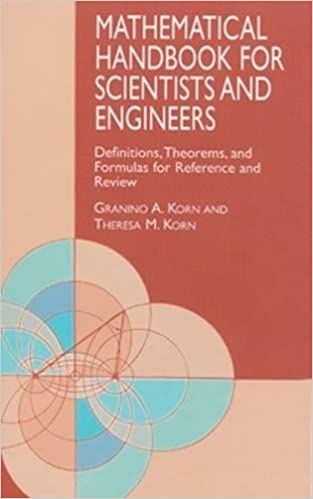
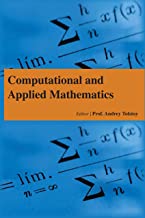
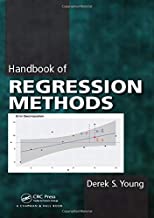
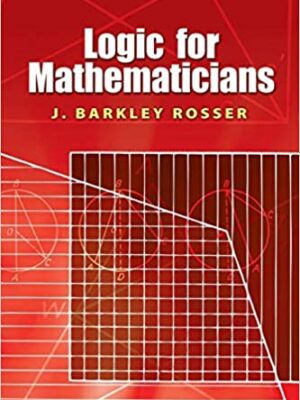
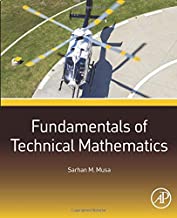
Reviews
There are no reviews yet.